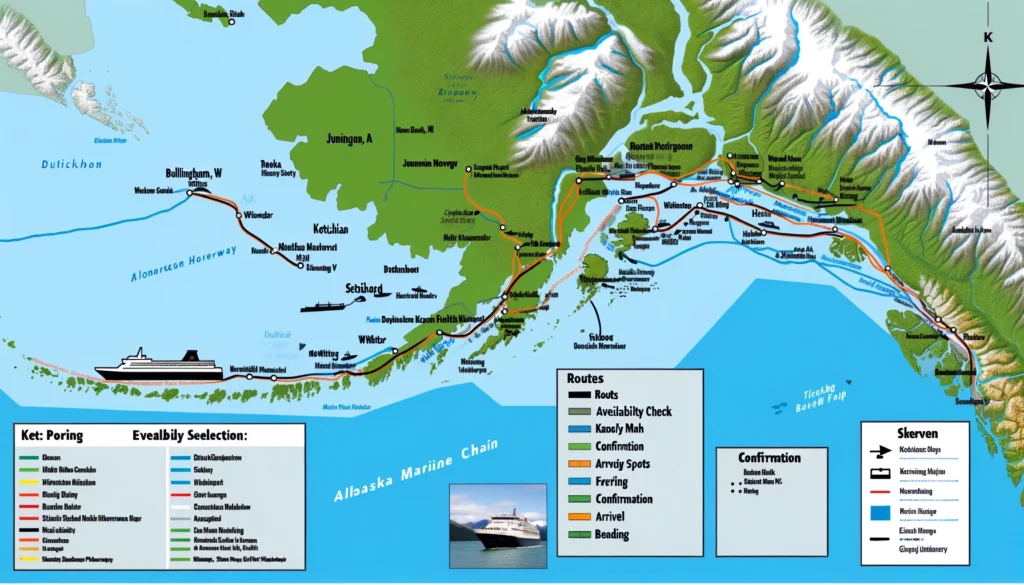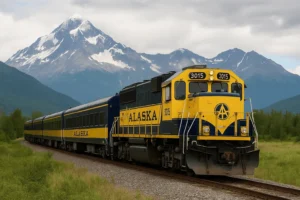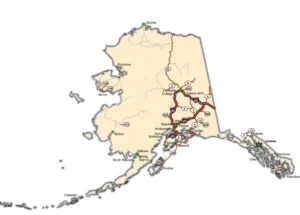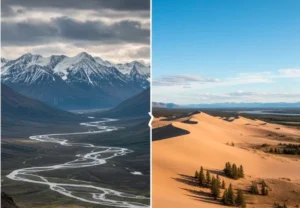The Alaska Marine Highway System is vital to Alaska’s transportation network, covering 3,500 miles of coastline and serving over 30 communities from Bellingham, Washington, to Dutch Harbor in the Aleutian Chain.
This system, known as the “Blue Canoes,” offers a unique way to experience Alaska up close and personal, connecting 33 ports and providing scenic routes designated as All-American Roads.
The ferries run for 8,834 miles, offering a non-touristy, no-frills way to cruise Alaska, allowing travelers to meet real Alaskans and enjoy the dramatic scenery and wildlife.
The vessels range from mainline ferries like the MV Columbia to shuttle ferries like the MV Hubbard, providing flexibility for travelers to access various communities and destinations.
What is the Alaska Marine Highway System?
The AMHS or Alaska Ferry System is a ferry service in Alaska, United States. It provides transportation for passengers and vehicles between various communities along the coastline of Alaska and some ports in British Columbia, Canada. The system is a vital link for many remote and isolated communities in Alaska, where road and air transportation may be limited or unavailable. The ferries to Alaska offer essential transit for residents and tourists and scenic voyages through some of Alaska’s most breathtaking places.
Alaska Marine Highway Booking Process
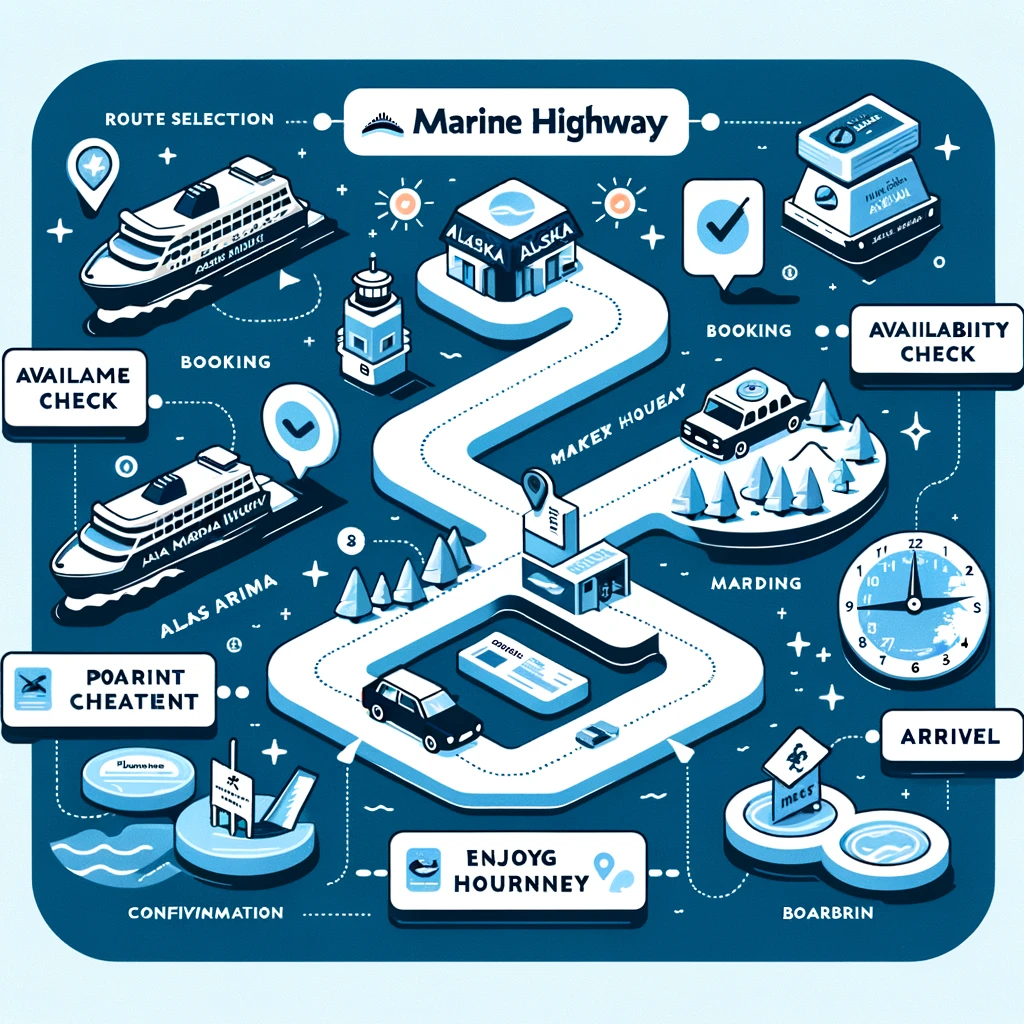
The booking process for the AK Marine Highway System involves several key steps and considerations:
- Route Selection: Choose the route you want to travel along and your journey dates.
- Availability Check: Verify the availability of your chosen route and dates online or by contacting the reservations call center.
- Booking: Provide accurate information about passengers and vehicles (if applicable) and complete the booking process.
- Payment: Pay for your reservation using the accepted payment methods.
- Confirmation: Receive your booking confirmation through email or other communication channels.
- Arrival: Arrive at the ferry terminal before the scheduled departure time.
- Boarding: Follow the instructions provided by AMHS staff for boarding the ferry.
- Enjoy Your Journey: Once onboard, relax and enjoy the journey along Alaska’s coastline, appreciating the scenic views and onboard amenities.
How Can I Pay For My Alaska Marine Highway Fare?
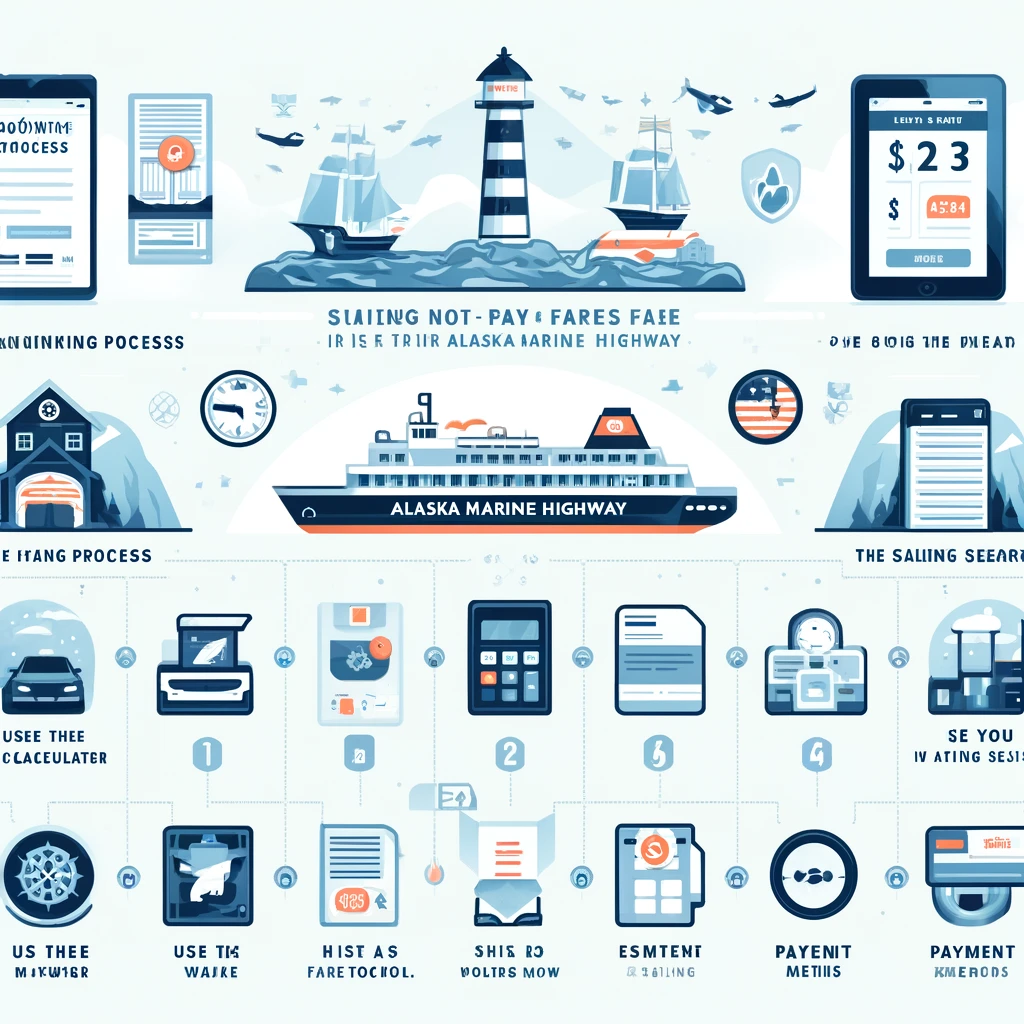
1. Booking Process:
Contact the Alaska Marine Highway System at 1-800-642-0066 or email them to make reservations and inquire about fares.
2. Online Fare Calculator:
Utilize the Alaska ferry fare calculator available on websites like alaskaferry.com to estimate the cost of your trip. This tool provides approximate costs for Alaska ferry travel, allowing you to plan and budget accordingly.
3. Sailing Search Tool:
Use the multi-purpose sailing search tool the AK Marine Highway System provides to check fares and availability based on your selected travel criteria. This tool functions as a pricing widget, making it convenient to find and confirm your preferred sailing with ease.
4. Payment Methods:
Once you have confirmed your reservation and fare, you can pay for your Alaska Marine Highway System fare using various payment methods accepted by the system. These methods may include credit cards, debit cards, and other forms of electronic payment. Confirming the accepted payment methods when making your reservation is advisable to ensure a smooth payment process.
Alaska Marine Highway System Routes
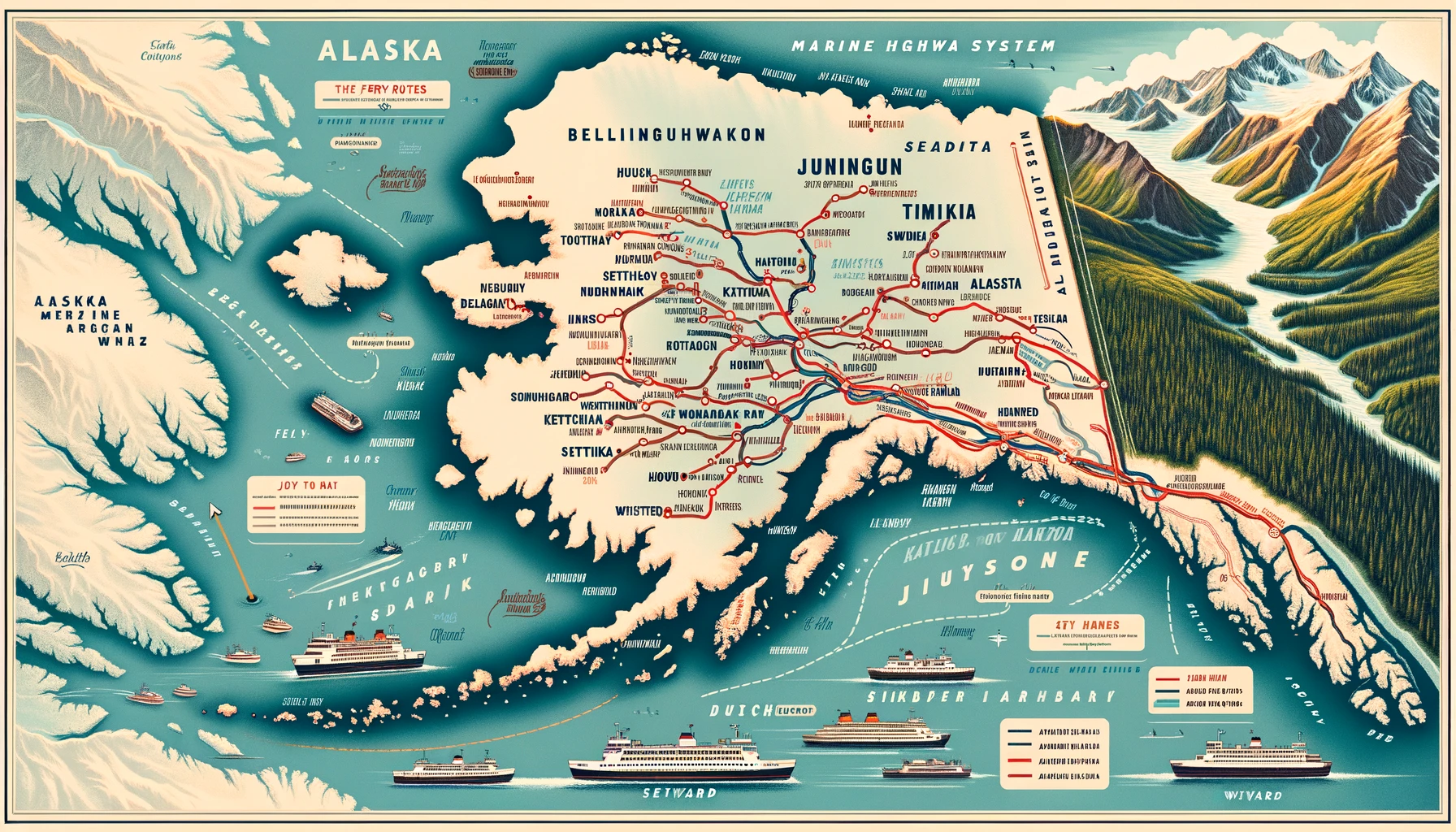
The Alaska Marine Highway System offers an extensive network of ferry routes spanning the captivating coastline of Alaska, serving over 30 communities from Bellingham, Washington, to Dutch Harbor in the Aleutian Chain.
These ferries provide vital transportation links to various regions, including the south-central coast, the eastern Aleutian Islands, and the scenic Inside Passage of Alaska and British Columbia, Canada.
Covering a remarkable 3,500 miles of coastline, the system operates 32 terminals throughout Alaska, British Columbia, and Washington.
From mainline vessels traversing long distances with multiple stops to shuttle ferries providing daily links between neighboring communities, travelers have diverse options to reach their desired destinations.
Let’s explore some of the key routes offered by the Alaska Marine Highway System:
Inside Passage Route:
This route meanders along the southeastern coast of Alaska, offering awe-inspiring views of fjords, glaciers, and abundant wildlife. Major ports of call along this route include Ketchikan, Juneau, and Sitka. Spanning approximately 3,500 miles, it’s a top choice for tourists seeking access to remote wilderness areas.
Gulf Coast Route:
Traveling along the southern coast, known as the “Gulf of Alaska” route, this journey provides access to the scenic Kenai Peninsula and Prince William Sound. Notable ports along the way include Homer, Seward, and Whittier. This route covers about 750 miles and is popular for fishing, wildlife viewing, and outdoor adventures.
Southwest Alaska Route:
Connecting communities in the southwest region, including Kodiak Island and the Aleutian Islands, this route is a lifeline to remote and isolated areas. Key ports such as Kodiak, Dutch Harbor, and Unalaska facilitate transportation, spanning approximately 2,500 miles and supporting goods, supplies, and passengers to these regions.
Bering Sea Route:
Linking western Alaska communities like Nome, Kotzebue, and Bethel, this route navigates the vast expanse of the Bering Sea. With ports including Nome, Kotzebue, and Bethel, it covers around 1,000 miles, providing essential transportation and services to remote villages and towns.
Cross-Gulf Route:
Spanning the Gulf of Alaska, this route connects southern Alaska with the Kenai Peninsula, Kodiak Island, and the Alaska Peninsula. Key ports along the way include Homer, Kodiak, and King Salmon. It covers approximately 900 miles and serves as a crucial lifeline for transporting passengers, vehicles, and freight between these remote regions.
Conclusion
The Alaska Marine Highway System is a lifeline for Alaska’s coastal communities, spanning 3,500 miles and serving over 30 destinations from Bellingham, Washington, to Dutch Harbor in the Aleutian Chain. With 32 terminals and various vessels, including mainline ferries and shuttle ferries, it offers flexibility and accessibility to travelers. Whether you’re exploring the Inside Passage’s scenic fjords, fishing along the Gulf Coast, or connecting with remote communities in Southwest Alaska, this system provides an authentic and unforgettable way to experience the diverse landscapes and cultures of the last frontier.
FAQs
How Does the Alaska Marine Highway Work?
The Alaska Marine Highway operates in South-central Alaska, the eastern Aleutian Islands, and the Inside Passage of Alaska and British Columbia, Canada, providing vital transportation to Southeast Alaska communities without road access for passengers, freight, and vehicles.u003cbru003e
How Long is the Alaska Marine Highway System?
The Highway System spans over 3,500 miles of coastline, connecting more than 30 communities from Bellingham, Washington, to Unalaska/Dutch Harbor in the Aleutian Chain.u003cbru003e
How Long Does the Alaska Marine Highway Take?
For example, it takes nearly three days to travel from Bellingham to Skagway and 18 hours for the Sitka to Juneau route.u003cbru003e
What are the Benefits of the Alaska Marine Highway?
The Alaska Marine Highway provides essential transportation to remote communities without road access, connects different regions of Alaska, offers scenic travel opportunities, transports freight, and supports tourism and local economies.u003cbru003e
Why is the Alaska Highway Famous?
The Alaska Highway is famous for being a historic and iconic roadway that stretches from Dawson Creek, British Columbia, in Canada, to Delta Junction, Alaska, in the United States. It gained fame during World War II as a strategic military route constructed remarkably quickly to connect the continental United States to Alaska. Today, it remains a popular route for travelers seeking adventure, stunning scenery, and access to remote wilderness areas in the northern regions of North America.u003cbru003e
What is the Purpose of the Alaska Highway?
The purpose of the Alaska Highway is to provide a vital transportation route connecting the contiguous United States with Alaska, facilitating travel, commerce, and military logistics.u003cbru003e
What is the Famous Alaska Highway?
The famous Alaska Highway is a historic roadway that extends from Dawson Creek, British Columbia, Canada, to Delta Junction, Alaska, USA, traversing rugged terrain and providing access to remote northern regions.u003cbru003e
Can You Drive from Canada to Alaska?
Yes, you can drive from Canada to Alaska via the Alaska Highway, which extends from Dawson Creek, British Columbia, Canada, to Delta Junction, Alaska, USA.u003cbru003e






